2024届高考英语:定语从句的底层逻辑和难点突破 课件(共36张PPT)
文档属性
| 名称 | 2024届高考英语:定语从句的底层逻辑和难点突破 课件(共36张PPT) | 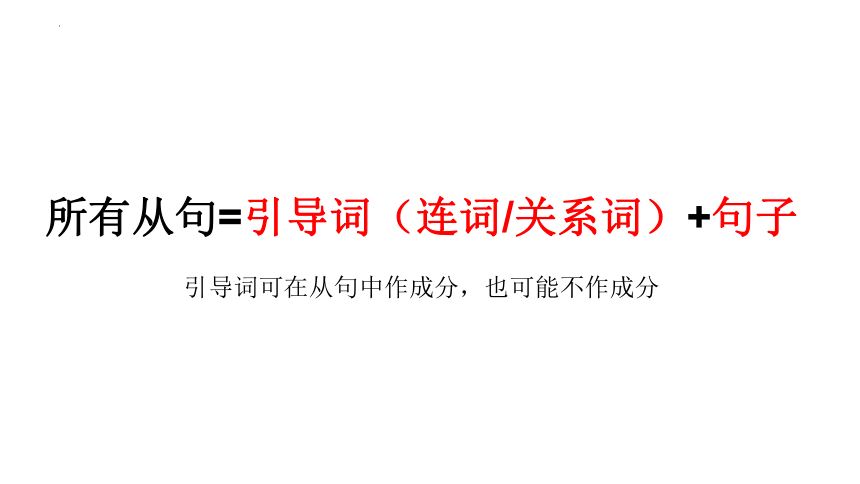 | |
| 格式 | pptx | ||
| 文件大小 | 195.9KB | ||
| 资源类型 | 教案 | ||
| 版本资源 | 通用版 | ||
| 科目 | 英语 | ||
| 更新时间 | 2023-10-30 19:55:54 | ||
图片预览

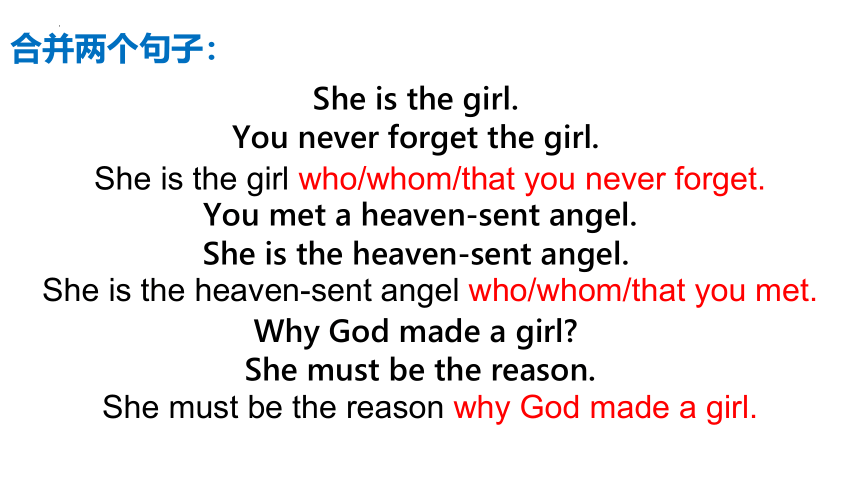
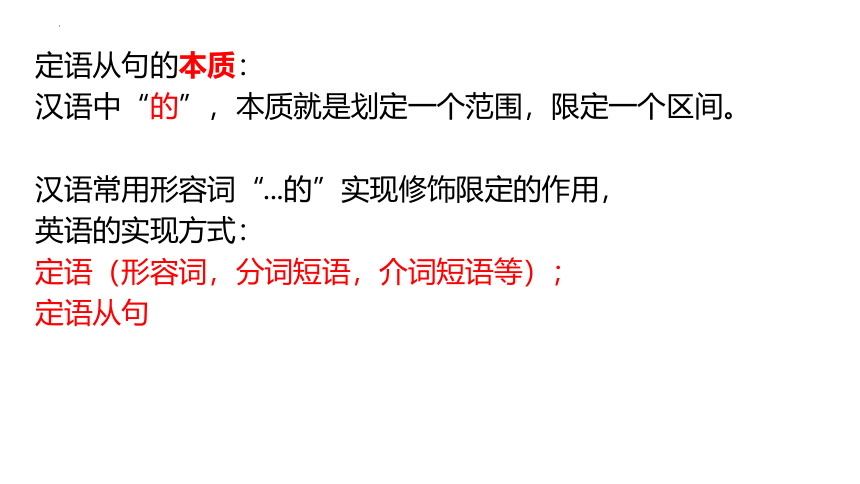
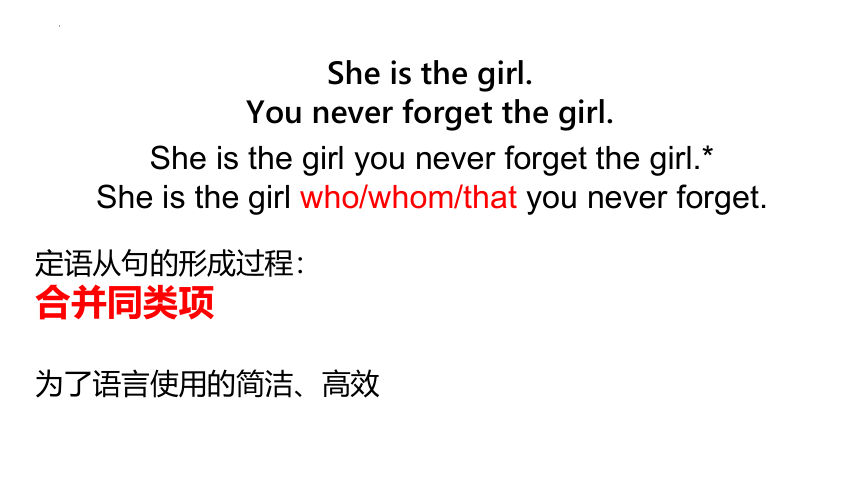
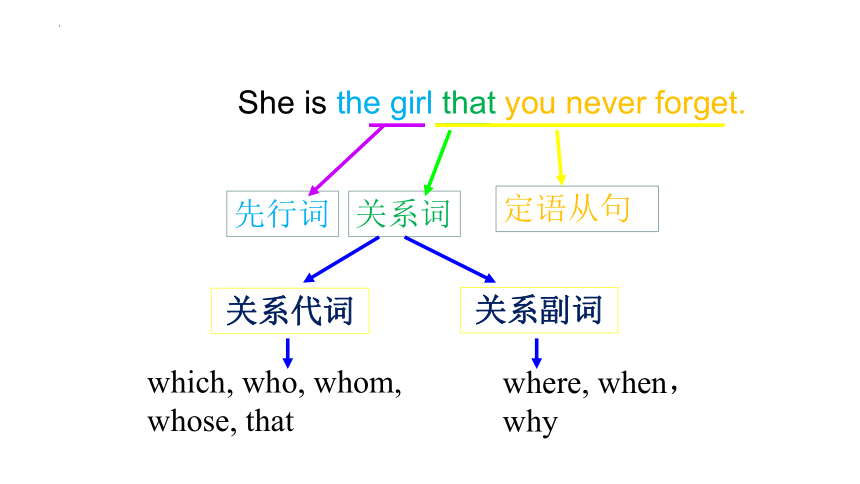
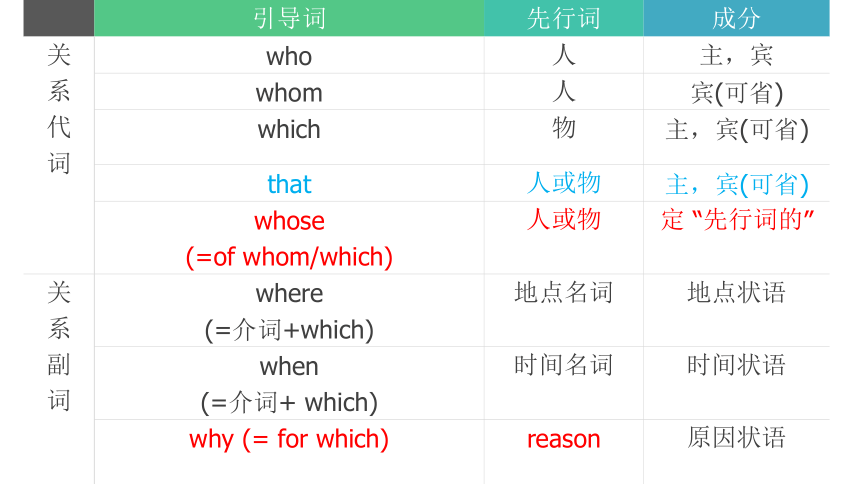
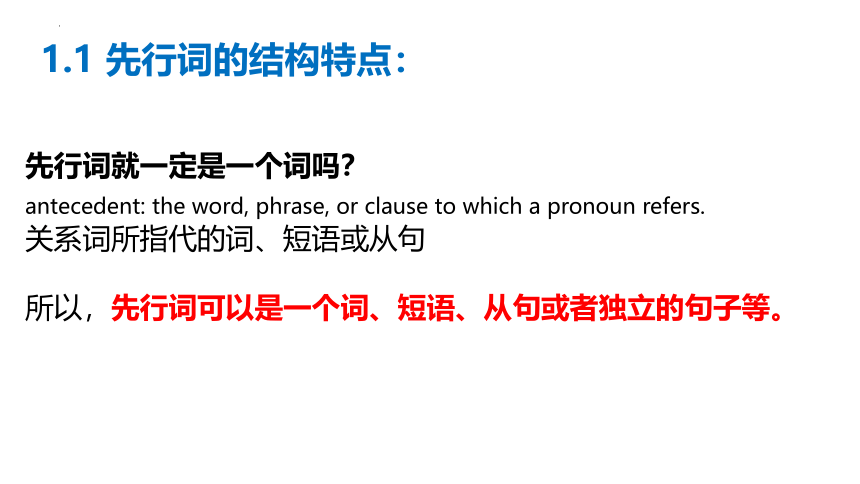
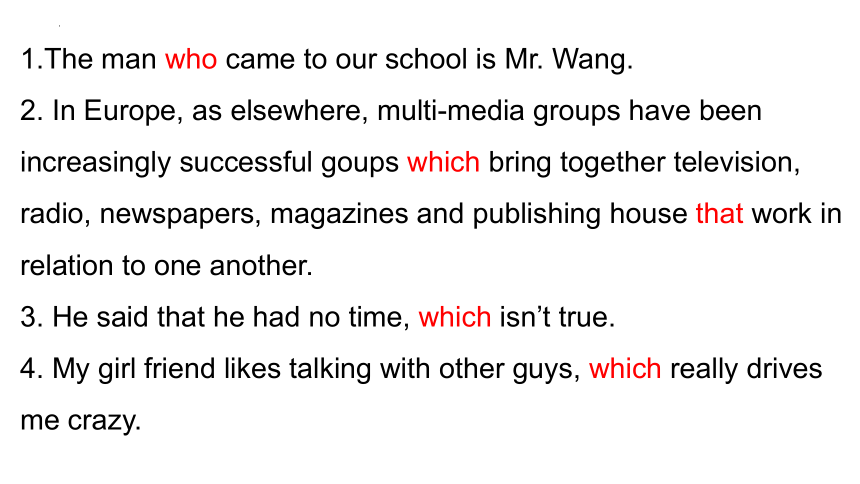
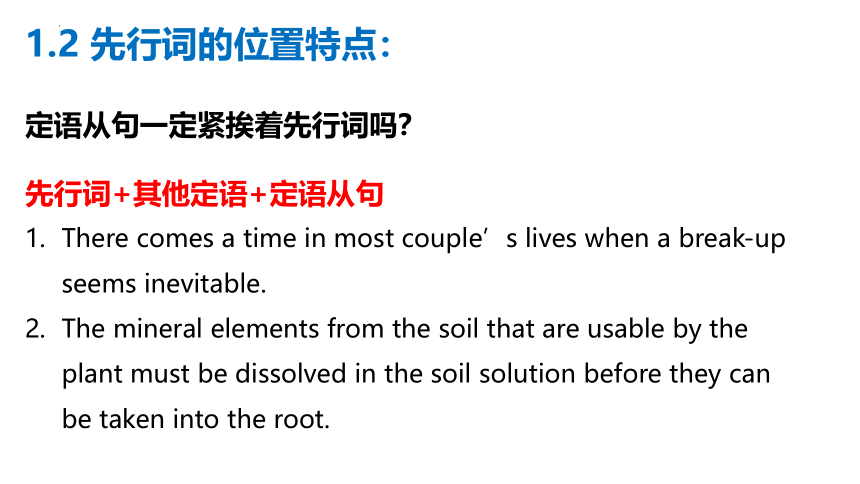
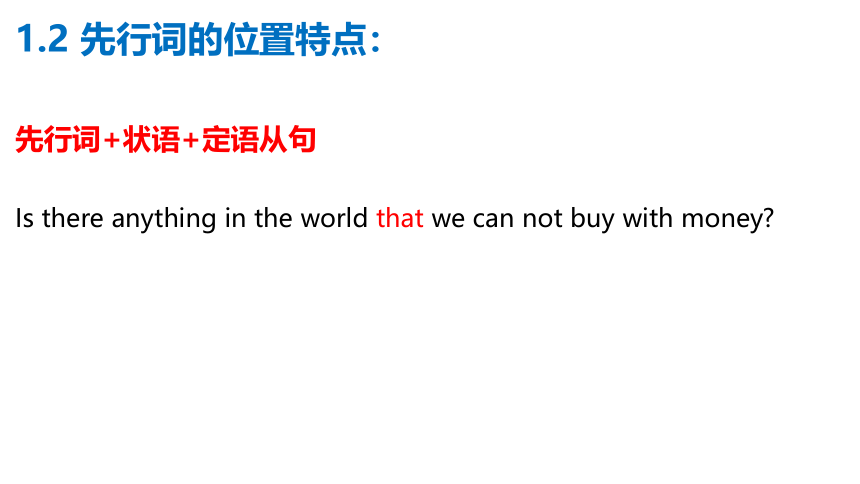

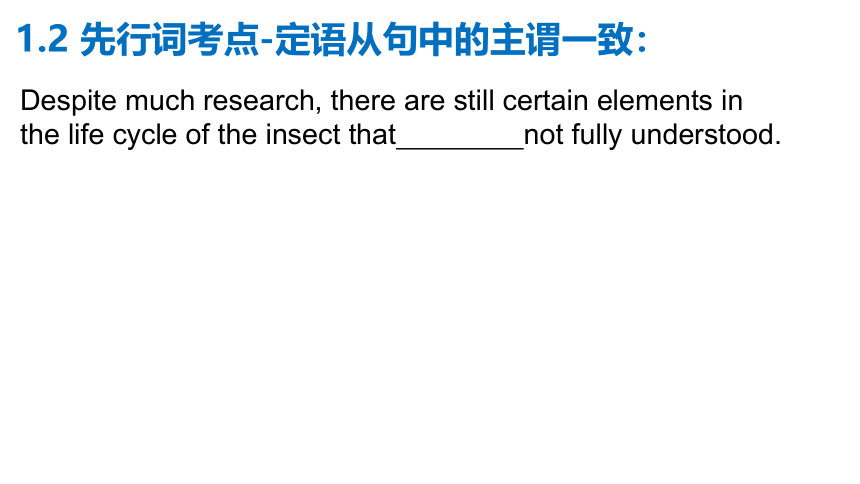
文档简介
(共36张PPT)
所有从句=引导词(连词/关系词)+句子
引导词可在从句中作成分,也可能不作成分
合并两个句子:
She is the girl.
You never forget the girl.
You met a heaven-sent angel.
She is the heaven-sent angel.
Why God made a girl
She must be the reason.
She is the girl who/whom/that you never forget.
She is the heaven-sent angel who/whom/that you met.
She must be the reason why God made a girl.
定语从句的本质:
汉语中“的”,本质就是划定一个范围,限定一个区间。
汉语常用形容词“...的”实现修饰限定的作用,
英语的实现方式:
定语(形容词,分词短语,介词短语等);
定语从句
She is the girl.
You never forget the girl.
She is the girl you never forget the girl.*
She is the girl who/whom/that you never forget.
定语从句的形成过程:
合并同类项
为了语言使用的简洁、高效
She is the girl that you never forget.
先行词
关系词
定语从句
关系代词
关系副词
which, who, whom, whose, that
where, when,why
引导词 先行词 成分
关 系 代 词 who 人 主,宾
whom 人 宾(可省)
which 物 主,宾(可省)
that 人或物 主,宾(可省)
whose (=of whom/which) 人或物 定 “先行词的”
关 系 副 词 where (=介词+which) 地点名词 地点状语
when (=介词+ which) 时间名词 时间状语
why (= for which) reason 原因状语
先行词就一定是一个词吗?
antecedent: the word, phrase, or clause to which a pronoun refers.
关系词所指代的词、短语或从句
所以,先行词可以是一个词、短语、从句或者独立的句子等。
1.1 先行词的结构特点:
1.The man who came to our school is Mr. Wang.
2. In Europe, as elsewhere, multi-media groups have been increasingly successful goups which bring together television, radio, newspapers, magazines and publishing house that work in relation to one another.
3. He said that he had no time, which isn’t true.
4. My girl friend likes talking with other guys, which really drives me crazy.
1.2 先行词的位置特点:
定语从句一定紧挨着先行词吗?
先行词+其他定语+定语从句
There comes a time in most couple’s lives when a break-up seems inevitable.
The mineral elements from the soil that are usable by the plant must be dissolved in the soil solution before they can be taken into the root.
1.2 先行词的位置特点:
先行词+状语+定语从句
Is there anything in the world that we can not buy with money
1.2 先行词的位置特点:
作主语的先行词+谓语部分+定语从句
It can be predicted, however, that from time to time questions will arise which will require specific scientific answers.
1.2 先行词考点-定语从句中的主谓一致:
Despite much research, there are still certain elements in the life cycle of the insect that not fully understood.
引导词 先行词 成分
关 系 代 词 who 人 主,宾
whom 人 宾(可省)
which 物 主,宾(可省)
that 人或物 主,宾(可省)
whose (=of whom/which) 人或物 定 “先行词的”
关 系 副 词 where (=介词+which) 地点名词 地点状语
when (=介词+ which) 时间名词 时间状语
why (= for which) reason 原因状语
1. The man came to our school is Mr. Wang.
2. The girl I met is Lucy.
3. I like the book you bought yesterday.
4. A child parents are dead is called Tom.
2 关系代词
whose有什么特别?
whose后面必须接一个名词,不能单独使用
表示“先行词的”
既可以指人,也可以指物
关系代词有what吗?
what不引导定语从句,what引导名词性从句.
what=先行词+关系代词
I want to give you I have.
I want to give you the book I have.
you found is a treasure.
The vase you found is a treasure.
2 关系代词
引导词 先行词 成分
关 系 代 词 who 人 主,宾
whom 人 宾(可省)
which 物 主,宾(可省)
that 人或物 主,宾(可省)
whose (=of whom/which) 人或物 定 “先行词的”
关 系 副 词 where (=介词+which) 地点名词 地点状语
when (=介词+ which) 时间名词 时间状语
why (= for which) reason 原因状语
whenwhen可用in/on/at/during... +which代替1.I still remember the day.2.I first met himonthe day.I still remember the dayI first met him.3关系副词wherewhere可用in/on/at/to... + which代替1.The factory is the place.2. I once workedinthe factory.The factory is the placeI once worked3关系副词whywhy可用for +which代替1.This is the reason.2.I was late for school for this reason.This is the reasonI was late for school.3关系副词3 关系副词
关系副词有how吗?
How不可以作为方式的关系副词。在英语中,若表示方式,常用以下四种句型:
1. the way+从句
2. the way that+从句
3. the way in which +从句
4. the manner that+ 从句
the way how + 从句 ×
I don’t like the way you speak to me.
Show me the way how you took a good picture.
1.首先分清主句和定语从句,确保主句的完整性;
2.确定定语从句的先行词(人还是物,不一定是一个词)
3.把先行词带回到定语从句中去,看其在定语从句中做什么语法成分(主语,宾语,定语或状语)
4.若先行词在从句中做主语、宾语或定语则选择关系代词,若在从句中做状语,则选择关系副词。
4 如何选用定语从句的关系词
1. I’ll never forget the days______________ we worked together.
2. I’ll never forget the days ___________ we spent together.
3. I went to the place I worked ten years ago.
4. I went to the place _____________ I visited ten years ago.
5. This is the reason ______________ he was late.
6. This is the reason ____________ he gave.
总结:
先行词为表示时间、地点、原因的名词后接定从,不一定就是when,where,why,还要考虑先行词在定从中作什么成分。注意观察定语从句中谓语动词的差别
先行词为表示时间、地点、原因的名词后接定从,一定用when,where,why引导吗?
I like movies which are adapted from famous novels.
I love my mother who is good to me.
I love my mother, who is good to me.
I am Li Hua, who is one of your students.
非限制性定从本质是一个插入语,起补充说明的作用。
限制性定从与非限制定从区别:
有无逗号隔开,与主句的关系。
5 限制性定从与非限制性定从
1. You can take any seat __________ is free.
2. This is the only thing_________ we can do.
3. The is the first place __________ I want to visit.
4. This is the most interesting book _________ I have ever read.
5. Though I can’t remember everything ____happened during the time in university,
6. I still remember some people and things _____were related to Eve, who used to be my roommate.
7. There is little _______ I can do to make up for the lost time.
8. Who is the person broke the window
9. Our school is no longer the place ____ it used to be.
10. There is a new type of shoes you might be fond of.
6 特殊规则及易混点
只用that却不用which/who的情况
1) 当先行词是不定代词或被它们修饰时:everything, anything, nothing, something, all, much, little, few, none,the one,every等
2)当先行词被the only , the very , the same , the last 等,形容词的最高级,序数词修饰时。
3)先行词既有人又有物时
4)当主句以who或which开头时,定语从句中引导词用that ,不
用which 或 who 。以避免重复。
5) 先行词在定语从句中作表语时
6) 在 there be结构中
多少不一,恰人物最序
Football, _______ is a very interesting game, is played all over the world.
2. This is the train by _____ we went to Beijing.
当先行词是事物时, 只用which却不用that的情况
1.介词后
2. 用于非限制定语从句中
1. I am reading Harry Porter, _____is an interesting
book.
2. I am reading Harry Porter. _____is an interesting
book.
3. He has two sons. Both of ________ are teachers.
4. He has two sons, both of ________ are teachers.
which
It
them
whom
1. I’ve come to the point I can’t stand him.
2. The country is in the situation a war will break out at any time.
总结:定语从句分别修饰point, situation, part, stage, condition,position,case,activity等表示“到了某种地步,在某种境况中”等抽象地点意义时,用where 引导。
1.This is the library_____ I borrowed the book.
2.It is from this library ____ I borrowed the book.
where
that
3. We all have heard the news_____ our team won the game.
4. We don’t believe in the news ________ he told us yesterday.
定语从句
强调句型
that
that/which
同位语从句
定语从句
定从还是强调句型?
定从还是同位语从句?
7 关系代词as
as引导限定性定语从句,
只能用在一些固定结构中,即有such,the same, as修饰的先行词后。
such...as..., the same ... as..., as...as...
She's not such a man would leave her work half done.
He is not the same person we know.
He tried to make as few mistakes he could avoid.
as引导非限定性定语从句,
1. 指代的通常是一个完整的句子;
2. 位置可以在句首、句中和句末。
is known to us all, the whale is not fish but a mammal.
is known to us all that the whale is not fish but a mammal.
is known to us all is that the whale is not fish but a mammal.
as和which都可以引导非限制性定从,区别是什么?
1. 位置
as,主句前中后都可以;which主句后
2. 语义
She failed again, was expected.
She failed again, was unexpected.
当主句和从句在内容上一致时,或者说从句的内容顺着主语的意思,用as。as有“正如...,由...而知”这样的意思;
当主句和从句在内容上不一致时,或者说从句的内容对主句的内容起消极作用,则多用which。which译为“这”。
7 关系代词as
1. It is such a big stone _____ nobody can lift.
2. It is such a big stone _____ nobody can lift it.
3. ______ is known to all, he is the best student.
4. Jim passed the driving test, _____ surprised everybody in the office.
总结:
1.such…that中的that引导的是结果状语从句,在句中不作成分。
such…as 中的as在定语从句中应充当主宾表。
如果后面成分完整,用that来引导结果状语从句;
如果后面句子成分不完整,则用as来引导定语从句。
3.as 与which引导非限制性定语从句都能指代整句内容,但定语从句位于句首时,只能用 as, 意为“正如、恰如”。
which
As
as
that
8 介词+关系代词 常用:介词+which/whom
关系代词前介词的确定
1. 根据从句中动词与先行词的逻辑关系
This is the car ____which I paid 100$.
This is the car ____which I spent 100$.
This is the car ____which I go to work every day.
This is the car ______ which I can’t go to work.
This is the car ____which the old man was knocked down
This is the car ____which a boy threw a stone.
This is the car ____which we talked .
This is the car ____which the window was broken
for
on
in
without
by
at
about
of
2. 根据从句中从句中动词或形容词的习惯搭配 Can you explain to me how to use these idioms which I’m not familiar.
3. 根据先行词与介词的搭配1949 was the year which the P.R.C. was founded.
Whose引起从句可转换为“ of +关系代词”,
即:the+ n + of +which/whom 或者of +which/whom + the+ n
They live in a house, door opens to the south.
They lived in a house, opens to the south.
They lived in a house, opens to the south.
先行词为事物,只用that却不用which的情况
1) 当先行词是不定代词或被它们修饰时:everything, anything, nothing, something, all, much, little, few, none,the one,every等
2)当先行词被the only , the very , the same , the last 等,形容词的最高级,序数词修饰时。
3)先行词既有人又有物时
4)当主句以who或which开头时,定语从句中引导词用that ,不
用which 或 who 。以避免重复。
5) 先行词在定语从句中作表语时
6) 在 there be结构中
多少不一,恰人物最序
在, anyone, those, he,that,you,they 作先行词时(指人), 用”who” 不用 “that”.
Anyone who breaks the law is punished.=Whoever breaks...
Those who break the law are punished.
He who has not been to the Great Wall is not a true man.
当先行词被某些定语修饰,明显说明先行词是人时
Do you know the women with a baby on her back who is working there
在 there be结构中,先行词为人时
There is a student who wants to see you.
当定从中有定从时
The student that won the first prize is the monitor who works hard.
引导非限制性定从时
She is my mother, who is good to me.
定语从句中有插入语时
Jack is a man who I believe is honest.
先行词为人,只用who却不用that的情况
所有从句=引导词(连词/关系词)+句子
引导词可在从句中作成分,也可能不作成分
合并两个句子:
She is the girl.
You never forget the girl.
You met a heaven-sent angel.
She is the heaven-sent angel.
Why God made a girl
She must be the reason.
She is the girl who/whom/that you never forget.
She is the heaven-sent angel who/whom/that you met.
She must be the reason why God made a girl.
定语从句的本质:
汉语中“的”,本质就是划定一个范围,限定一个区间。
汉语常用形容词“...的”实现修饰限定的作用,
英语的实现方式:
定语(形容词,分词短语,介词短语等);
定语从句
She is the girl.
You never forget the girl.
She is the girl you never forget the girl.*
She is the girl who/whom/that you never forget.
定语从句的形成过程:
合并同类项
为了语言使用的简洁、高效
She is the girl that you never forget.
先行词
关系词
定语从句
关系代词
关系副词
which, who, whom, whose, that
where, when,why
引导词 先行词 成分
关 系 代 词 who 人 主,宾
whom 人 宾(可省)
which 物 主,宾(可省)
that 人或物 主,宾(可省)
whose (=of whom/which) 人或物 定 “先行词的”
关 系 副 词 where (=介词+which) 地点名词 地点状语
when (=介词+ which) 时间名词 时间状语
why (= for which) reason 原因状语
先行词就一定是一个词吗?
antecedent: the word, phrase, or clause to which a pronoun refers.
关系词所指代的词、短语或从句
所以,先行词可以是一个词、短语、从句或者独立的句子等。
1.1 先行词的结构特点:
1.The man who came to our school is Mr. Wang.
2. In Europe, as elsewhere, multi-media groups have been increasingly successful goups which bring together television, radio, newspapers, magazines and publishing house that work in relation to one another.
3. He said that he had no time, which isn’t true.
4. My girl friend likes talking with other guys, which really drives me crazy.
1.2 先行词的位置特点:
定语从句一定紧挨着先行词吗?
先行词+其他定语+定语从句
There comes a time in most couple’s lives when a break-up seems inevitable.
The mineral elements from the soil that are usable by the plant must be dissolved in the soil solution before they can be taken into the root.
1.2 先行词的位置特点:
先行词+状语+定语从句
Is there anything in the world that we can not buy with money
1.2 先行词的位置特点:
作主语的先行词+谓语部分+定语从句
It can be predicted, however, that from time to time questions will arise which will require specific scientific answers.
1.2 先行词考点-定语从句中的主谓一致:
Despite much research, there are still certain elements in the life cycle of the insect that not fully understood.
引导词 先行词 成分
关 系 代 词 who 人 主,宾
whom 人 宾(可省)
which 物 主,宾(可省)
that 人或物 主,宾(可省)
whose (=of whom/which) 人或物 定 “先行词的”
关 系 副 词 where (=介词+which) 地点名词 地点状语
when (=介词+ which) 时间名词 时间状语
why (= for which) reason 原因状语
1. The man came to our school is Mr. Wang.
2. The girl I met is Lucy.
3. I like the book you bought yesterday.
4. A child parents are dead is called Tom.
2 关系代词
whose有什么特别?
whose后面必须接一个名词,不能单独使用
表示“先行词的”
既可以指人,也可以指物
关系代词有what吗?
what不引导定语从句,what引导名词性从句.
what=先行词+关系代词
I want to give you I have.
I want to give you the book I have.
you found is a treasure.
The vase you found is a treasure.
2 关系代词
引导词 先行词 成分
关 系 代 词 who 人 主,宾
whom 人 宾(可省)
which 物 主,宾(可省)
that 人或物 主,宾(可省)
whose (=of whom/which) 人或物 定 “先行词的”
关 系 副 词 where (=介词+which) 地点名词 地点状语
when (=介词+ which) 时间名词 时间状语
why (= for which) reason 原因状语
whenwhen可用in/on/at/during... +which代替1.I still remember the day.2.I first met himonthe day.I still remember the dayI first met him.3关系副词wherewhere可用in/on/at/to... + which代替1.The factory is the place.2. I once workedinthe factory.The factory is the placeI once worked3关系副词whywhy可用for +which代替1.This is the reason.2.I was late for school for this reason.This is the reasonI was late for school.3关系副词3 关系副词
关系副词有how吗?
How不可以作为方式的关系副词。在英语中,若表示方式,常用以下四种句型:
1. the way+从句
2. the way that+从句
3. the way in which +从句
4. the manner that+ 从句
the way how + 从句 ×
I don’t like the way you speak to me.
Show me the way how you took a good picture.
1.首先分清主句和定语从句,确保主句的完整性;
2.确定定语从句的先行词(人还是物,不一定是一个词)
3.把先行词带回到定语从句中去,看其在定语从句中做什么语法成分(主语,宾语,定语或状语)
4.若先行词在从句中做主语、宾语或定语则选择关系代词,若在从句中做状语,则选择关系副词。
4 如何选用定语从句的关系词
1. I’ll never forget the days______________ we worked together.
2. I’ll never forget the days ___________ we spent together.
3. I went to the place I worked ten years ago.
4. I went to the place _____________ I visited ten years ago.
5. This is the reason ______________ he was late.
6. This is the reason ____________ he gave.
总结:
先行词为表示时间、地点、原因的名词后接定从,不一定就是when,where,why,还要考虑先行词在定从中作什么成分。注意观察定语从句中谓语动词的差别
先行词为表示时间、地点、原因的名词后接定从,一定用when,where,why引导吗?
I like movies which are adapted from famous novels.
I love my mother who is good to me.
I love my mother, who is good to me.
I am Li Hua, who is one of your students.
非限制性定从本质是一个插入语,起补充说明的作用。
限制性定从与非限制定从区别:
有无逗号隔开,与主句的关系。
5 限制性定从与非限制性定从
1. You can take any seat __________ is free.
2. This is the only thing_________ we can do.
3. The is the first place __________ I want to visit.
4. This is the most interesting book _________ I have ever read.
5. Though I can’t remember everything ____happened during the time in university,
6. I still remember some people and things _____were related to Eve, who used to be my roommate.
7. There is little _______ I can do to make up for the lost time.
8. Who is the person broke the window
9. Our school is no longer the place ____ it used to be.
10. There is a new type of shoes you might be fond of.
6 特殊规则及易混点
只用that却不用which/who的情况
1) 当先行词是不定代词或被它们修饰时:everything, anything, nothing, something, all, much, little, few, none,the one,every等
2)当先行词被the only , the very , the same , the last 等,形容词的最高级,序数词修饰时。
3)先行词既有人又有物时
4)当主句以who或which开头时,定语从句中引导词用that ,不
用which 或 who 。以避免重复。
5) 先行词在定语从句中作表语时
6) 在 there be结构中
多少不一,恰人物最序
Football, _______ is a very interesting game, is played all over the world.
2. This is the train by _____ we went to Beijing.
当先行词是事物时, 只用which却不用that的情况
1.介词后
2. 用于非限制定语从句中
1. I am reading Harry Porter, _____is an interesting
book.
2. I am reading Harry Porter. _____is an interesting
book.
3. He has two sons. Both of ________ are teachers.
4. He has two sons, both of ________ are teachers.
which
It
them
whom
1. I’ve come to the point I can’t stand him.
2. The country is in the situation a war will break out at any time.
总结:定语从句分别修饰point, situation, part, stage, condition,position,case,activity等表示“到了某种地步,在某种境况中”等抽象地点意义时,用where 引导。
1.This is the library_____ I borrowed the book.
2.It is from this library ____ I borrowed the book.
where
that
3. We all have heard the news_____ our team won the game.
4. We don’t believe in the news ________ he told us yesterday.
定语从句
强调句型
that
that/which
同位语从句
定语从句
定从还是强调句型?
定从还是同位语从句?
7 关系代词as
as引导限定性定语从句,
只能用在一些固定结构中,即有such,the same, as修饰的先行词后。
such...as..., the same ... as..., as...as...
She's not such a man would leave her work half done.
He is not the same person we know.
He tried to make as few mistakes he could avoid.
as引导非限定性定语从句,
1. 指代的通常是一个完整的句子;
2. 位置可以在句首、句中和句末。
is known to us all, the whale is not fish but a mammal.
is known to us all that the whale is not fish but a mammal.
is known to us all is that the whale is not fish but a mammal.
as和which都可以引导非限制性定从,区别是什么?
1. 位置
as,主句前中后都可以;which主句后
2. 语义
She failed again, was expected.
She failed again, was unexpected.
当主句和从句在内容上一致时,或者说从句的内容顺着主语的意思,用as。as有“正如...,由...而知”这样的意思;
当主句和从句在内容上不一致时,或者说从句的内容对主句的内容起消极作用,则多用which。which译为“这”。
7 关系代词as
1. It is such a big stone _____ nobody can lift.
2. It is such a big stone _____ nobody can lift it.
3. ______ is known to all, he is the best student.
4. Jim passed the driving test, _____ surprised everybody in the office.
总结:
1.such…that中的that引导的是结果状语从句,在句中不作成分。
such…as 中的as在定语从句中应充当主宾表。
如果后面成分完整,用that来引导结果状语从句;
如果后面句子成分不完整,则用as来引导定语从句。
3.as 与which引导非限制性定语从句都能指代整句内容,但定语从句位于句首时,只能用 as, 意为“正如、恰如”。
which
As
as
that
8 介词+关系代词 常用:介词+which/whom
关系代词前介词的确定
1. 根据从句中动词与先行词的逻辑关系
This is the car ____which I paid 100$.
This is the car ____which I spent 100$.
This is the car ____which I go to work every day.
This is the car ______ which I can’t go to work.
This is the car ____which the old man was knocked down
This is the car ____which a boy threw a stone.
This is the car ____which we talked .
This is the car ____which the window was broken
for
on
in
without
by
at
about
of
2. 根据从句中从句中动词或形容词的习惯搭配 Can you explain to me how to use these idioms which I’m not familiar.
3. 根据先行词与介词的搭配1949 was the year which the P.R.C. was founded.
Whose引起从句可转换为“ of +关系代词”,
即:the+ n + of +which/whom 或者of +which/whom + the+ n
They live in a house, door opens to the south.
They lived in a house, opens to the south.
They lived in a house, opens to the south.
先行词为事物,只用that却不用which的情况
1) 当先行词是不定代词或被它们修饰时:everything, anything, nothing, something, all, much, little, few, none,the one,every等
2)当先行词被the only , the very , the same , the last 等,形容词的最高级,序数词修饰时。
3)先行词既有人又有物时
4)当主句以who或which开头时,定语从句中引导词用that ,不
用which 或 who 。以避免重复。
5) 先行词在定语从句中作表语时
6) 在 there be结构中
多少不一,恰人物最序
在, anyone, those, he,that,you,they 作先行词时(指人), 用”who” 不用 “that”.
Anyone who breaks the law is punished.=Whoever breaks...
Those who break the law are punished.
He who has not been to the Great Wall is not a true man.
当先行词被某些定语修饰,明显说明先行词是人时
Do you know the women with a baby on her back who is working there
在 there be结构中,先行词为人时
There is a student who wants to see you.
当定从中有定从时
The student that won the first prize is the monitor who works hard.
引导非限制性定从时
She is my mother, who is good to me.
定语从句中有插入语时
Jack is a man who I believe is honest.
先行词为人,只用who却不用that的情况
